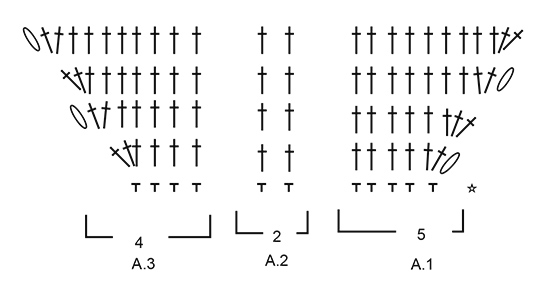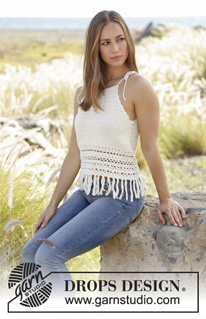Comments / Questions (47)
![]() Weiss wrote:
Weiss wrote:
Je ne comprends pas comment débuter le modèle : le 1er rang. Les mailles serrées dans chacune des 0-2-2-0-0-2 ? Comment arrive t on à 35 mailles à la fin du rang?
09.06.2024 - 21:05DROPS Design answered:
Bonjour Mme Weiss, comme la chaînette de base est généralement plus serrée, on va ici crocheter davantage de mailles en l'air (44) que l'on a besoin de ms (35) et crocheter ainsi (M): 1 ms dans la 2ème ml à partir du crochet (1 ms / 2 ml), 1 ms dans les 2 m suiv (2ms/ 2 ml), *sauter 1 ml, 1 ms dans les. 4 m suiv* (4 ms/5 ml) x 8 on a ainsi 2+2+(5X8)=44 ml et 1+2+(4x8)=35 ms. Bon crochet!
10.06.2024 - 08:34
![]() Elly De Clercq wrote:
Elly De Clercq wrote:
Bij het haken van het voorpand maat medium eindig je met 71 stokjes. Volgens de afmetingen op de tekening heb je dan 14cm. Ik kom maar aan 11,5cm. Haak ik dan verder tot 14cm zonder meerderen? Ik haak met naald 2,5cm na het proeflapje.
16.07.2023 - 12:00DROPS Design answered:
Dag Elly,
Het is inderdaad de bedoeling dat je 11 cm hebt. Komt de stekenverhouding in de hoogte ook overeen met de stekenverhouding in het patroon? Als je werk korter in de hoogte wordt door een andere stekenverhouding, dan zou je de meerderingen anders moeten verdelen, want het lijkt niet mooi om nog door te haken zonder minderingen te maken. Je zou ook even kunnen kijken of je misschien toch uit de voeten kunt met deze 11,5 cm, door bijvoorbeeld de bandjes wat langer te maken. Op die manier hoef je het werk niet uit te halen.
18.07.2023 - 20:56
![]() Dea wrote:
Dea wrote:
Buongiorno, ho bisogno un aiuto. Dopo aver unito il lavoro mi trovo a dover fare gli aumenti ogni tot cm. Mi dice di farlo ogni 3 cm. Vuol dire che devo farlo sul giro dopo che ho raggiunto i 3 cm o su quello che mi fa raggiungere i 3 cm? Spiego meglio, se faccio 2 giri il lavoro è 2 cm , se faccio il terzo mi trovo a 3. Quindi? Grazie.
15.07.2023 - 16:44DROPS Design answered:
Buongiorno Dea, può lavorare l'aumento al raggiungimento dei 3 cm, quindi dopo il terzo giro. Buon lavoro!
16.07.2023 - 13:17
![]() Ana wrote:
Ana wrote:
Necesito ayuda para entender cómo hacer la 1° pasada, no entiendo la parte que pone, trabajar un punto bajo en cada uno de los siguientes 0-2-2-0-0-2 puntos de cadeneta. Gracias
28.04.2023 - 22:47DROPS Design answered:
Hola Ana, las instrucciones están escritas para varias tallas a la vez. Dependiendo de la talla que estés trabajando, trabajarás un punto bajo en los siguientes 2 puntos de cadeneta o, si pone 0, ignora esta parte de la frase y pasa directamente a las siguientes instrucciones en la fila. Por ejemplo, en la talla más pequeña (S), no trabajas 1 punto bajo en los siguientes 2 puntos, pero en las tallas M y L sí.
30.04.2023 - 20:02
![]() Linda Houtman wrote:
Linda Houtman wrote:
Halli, ik maak maat S. Als je begint met 42 losse en ik meet na toer 2, dan kom je echt niet aan de breedte van 18 cm, zoals op tekening staat aangegeven. En zoals gezegd, bij proeflapje klopte mn steekverhouding. Kloppen die centimeters wel die op tekening staan aangegeven? Volgens mij niet! Groet, Linda
04.06.2022 - 20:15DROPS Design answered:
Dag Linda,
Het werk wordt van boven naar beneden gehaakt en na de 1e toer heb je 33 vasten waarin het patroon gehaakt wordt. 33 delen door 1,8 (de stekenverhouding) = ruim 18 cm breed. Dit komt overeen met de breedte van de hals in de tekening onderaan.
05.06.2022 - 20:44
![]() Linda Houtman wrote:
Linda Houtman wrote:
Hallo, ik maak maat S, maar topje is veels te wijd (stekenverhouding klopt, en hen nergens fout gemaakt). Stel dat ik veel minder ga meerderen, op hoeveel steken moet ik dan eindigen voordat ik aan A4/A5 begin? Hoeveelheid van.....? Groet, Linda
04.06.2022 - 09:03DROPS Design answered:
Dag Linda,
Voor een breedte van 40 cm (bovenwijdte) heb je ongeveer 72 stokjes nodig, dus voor het voor- en achterpand samen in totaal 144 stokjes. Als je de 66 stokjes van het voor- en achterpand bij elkaar optelt met de 2 keer 6 lossen er tussen, dan kom je precies op 144 lossen, dus dat zou moeten kloppen. Dan komen er nog 19 steken bij in totaal, dus dat zou ook overeen moeten komen met de breedte van 44 cm onderaan.
05.06.2022 - 20:57
![]() Ursula wrote:
Ursula wrote:
Ik heb nog n vraag. Ik ben klaar met denkpatroon A1t/mA3 en moet verder met meerderingen. Staat op dezelfde manier 11 toeren. Meerder 3 stokjes per toer. Moet je dan ook de 2 stokjes haken bij begin van toer incl de 5 losse?? Dat heb ik nl gedaan en heb ik al bij toer 10 75 stokjes.. Ik doe dus iets verkeerd. Wat moet ik nu precies haken. Alleen de laatste 3 stokjes???
08.07.2021 - 22:06DROPS Design answered:
Dag Ursula,
Je gaat op dezelfde manier verder met meerderen, dus je meerdert 3 steken per toer. De 5 lossen tellen niet mee in het aantal steken. Als je goed kijkt naar het telpatroon, zie je dat er 3 steken per toer gemeerderd wordt; 1 stokje aan het begin en 2 stokjes aan het eind van de toer. Na 11 toeren zijn er dan 33 stokjes bij gekomen.
20.07.2021 - 15:26
![]() Ursula wrote:
Ursula wrote:
Hi ik ben een beginner en ik begrijp dit niet: " Keer en haak als volgt: haak 1 vaste in tweede losse vanaf haak (= 1 vaste en 1 losse om mee te keren), haak 1 vaste in elke van de volgende 0-2-2-0-0-2 lossen, * sla 1 losse over, haak 1 vaste in elke van de volgende 4 lossen *, herhaal van *-* nog 7-7-7-8-8-8 keer = 33-35-35-37-37-39 vasten. " Wat moet ik doen met haak 1 vaste in elke van de volgende 0 losse???? Ik haak maatje S.
01.07.2021 - 23:03DROPS Design answered:
Dag Ursula,
Omdat dit in jouw maat 0 keer is hoef je daar dus niks mee te doen en ga je verder met het volgende stukje.
02.07.2021 - 09:22
![]() Van Eeghem Kathleen wrote:
Van Eeghem Kathleen wrote:
Met welk wasmiddel kan ik dit topje wassen?
09.06.2021 - 16:59DROPS Design answered:
Dag Kathleen,
Een kledingstuk van Muskat hoort bij de fijne was, dus ook een wasmiddel voor fijne was is het meest geschikt.
11.06.2021 - 12:26
![]() Sina Van Den Hoek wrote:
Sina Van Den Hoek wrote:
Is deze in het nederlands
25.05.2020 - 23:12
Hawaiian Breeze#hawaiianbreezetop |
|||||||||||||||||||||||||
|
|
|||||||||||||||||||||||||
Crochet top with lace pattern and fringes in DROPS Muskat. Size: S - XXXL
DROPS 175-27 |
|||||||||||||||||||||||||
|
CROCHET INFO: At beginning of every row with treble crochets in A.1 and A.3 work 5 chain stitches to turn with. These 5 chain stitches do not replace first treble crochet. When working in the round, replace the first treble crochet with 3 chain stitches, finish round with 1 slip stitch in 3rd chain stitch at beginning of round. PATTERN: See diagrams A.1 to A.5. INCREASE TIP: Increase by working 2 treble crochets in 1 treble crochet. ---------------------------------------------------------- TOP: Top is worked top down. First work front piece and back piece back and forth separately, then work in the round over both parts. FRONT PIECE: Work 42-44-44-47-47-49 loose chain stitches on hook size 4 mm with Muskat. Turn and work as follows: Work 1 double crochet in second chain stitch from hook (= 1 double crochet + 1 chain stitch to turn with), work 1 double crochet in each of the next 0-2-2-0-0-2 chain stitches, * skip 1 chain stitch, work 1 double crochet in each of the next 4 chain stitches *, repeat from *-* 7-7-7-8-8-8 more times = 33-35-35-37-37-39 double crochets. Turn and work pattern as follows: Begin on 2nd row. Work A.1 over the first 5 double crochet, A.2 over the next 24-26-26-28-28-30 double crochets, A.3 over the remaining 4 double crochet - READ CROCHET INFO. REMEMBER THE CROCHET TENSION! When diagram A.1 to A.3 have been done vertically, continue with treble crochets and increases the same way until 11-12-13-14-15-16 rows with increases have been worked in total (increase 3 treble crochets on every row). There are now 66-71-74-79-82-87 treble crochets on row. Put piece aside. BACK PIECE: Work the same way as on front piece. BODY: Now work the two parts together as follows: Turn and work 1 treble crochet in each of the 66-71-74-79-82-87 treble crochets from back piece, work 6-12-12-16-24-30 chain stitches, work 1 treble crochet in each of the 66-71-74-79-82-87 treble crochets from front piece, work 6-12-12-16-24-30 chain stitches and finish with 1 slip stitch in 3rd chain stitch at beginning of round. Then work piece in the round, continue with 1 treble crochet in every treble crochet/chain stitch = 144-166-172-190-212-234 treble crochets. When working in the round, turn after every round to work alternately from right side and wrong side. This is so that the texture is the same on the entire top. Insert 1 marker thread in each side, in the middle of the 6-12-12-16-24-30 chain stitches. NOW MEASURE THE PIECE FROM HERE. When piece measures 4 cm, increase 1 treble crochet on each side of each marker thread - READ INCREASE TIP. Increase every 3-3-3-3-4-4 cm 4 times in total = 160-182-188-206-228-250 treble crochets. Piece now measures 14-15-15-16-17-18 cm work 1 round while increasing 3-5-5-5-1-3 treble crochets evenly = 163-187-193-211-229-253 treble crochets, then work as follows: Work A.4 over the first treble crochet on round, then repeat A.5 over the remaining treble crochets. A.4 shows beginning and end of round. Do not turn, work all rounds from right side. Fasten off when A.4 and A.5 have been worked 1 time vertically. Piece measures approx. 40-42-44-46-48-50 cm in total. TIE: Work 2 loose ties as follows: Work chain stitches with Muskat on hook size 4 mm until the tie measures 100 cm, turn and work 1 slip stitch in every chain stitch but make sure that the slipped stitches are not worked tighter than chain stitches. Fasten off. Work another tie the same way. Baste tie through one side on front piece, between second and third treble crochet from edge in the first row with treble crochets. Baste tie through one side on back piece the same way and tie a knot on shoulder. Repeat on the other side of top. FRINGES: Cut 4 lengths of yarn of 20 cm. Place them double, thread loop from right side between 2 treble crochets at the bottom of body. Then pull yarn ends through loops and tighten. Fasten fringes approx. 2 cm apart at the bottom of top. |
|||||||||||||||||||||||||
Diagram explanations |
|||||||||||||||||||||||||
|
|||||||||||||||||||||||||

|
|||||||||||||||||||||||||

|
|||||||||||||||||||||||||
Have you finished this pattern?Tag your pictures with #dropspattern #hawaiianbreezetop or submit them to the #dropsfan gallery. Do you need help with this pattern?You'll find 9 tutorial videos, a Comments/Questions area and more by visiting the pattern on garnstudio.com. © 1982-2025 DROPS Design A/S. We reserve all rights. This document, including all its sub-sections, has copyrights. Read more about what you can do with our patterns at the bottom of each pattern on our site. |
|||||||||||||||||||||||||


















































Post a comment to pattern DROPS 175-27
We would love to hear what you have to say about this pattern!
If you want to leave a question, please make sure you select the correct category in the form below, to speed up the answering process. Required fields are marked *.